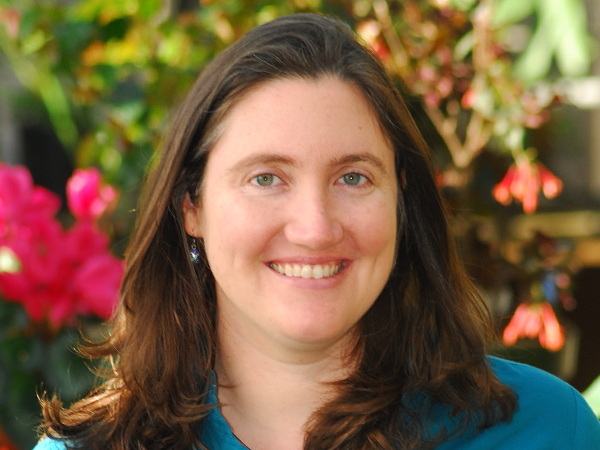The award recognizes Katherine’s innovative teaching techniques and her creative use of technology in the classroom. Established in 2011, the ADInstruments Macknight Early Career Innovative Educator Award recognizes an APS member who demonstrates the greatest potential for incorporating innovative teaching techniques and effectively utilizing technology to engage undergraduate students in physiology education.

Katherine teaches neurophysiology, cardiorespiratory physiology and integrative physiology at San Josè State University, as well as the freshman introductory biology class with over 460 students. She’s found ways to use technology to teach both small groups and large lecture halls full of students.
Of the award, Katherine Wilkinson says, “First of all, it’s a true honor to be recognized by my peers for my teaching. This award is also pretty special because one of the students in my lab encouraged me to apply – it’s nice to hear from your students that they think you’re a good teacher as well!”
We talked to Katherine about some of the ways she utilizes technology to increase student engagement, interaction...and even attendance!
How do you utilize technology in your teaching?
In my smaller class in neurophysiology, technology has really helped to free up time in class to have more discussions and problem-solving sessions with the students. To do this, I made some short lecture videos – just 5 to 20 minutes long – that I assign them to watch before coming to class. To gauge how much they’ve learned from the video and what they still find confusing, the students do an online quiz that’s due a couple of hours before class. So I look at that and can figure out which topics they know and which they need help with. Then I can tailor what we go over in class to make sure we hit the topics where they have misconceptions.Because they’ve already gone over the basic information beforehand, we can actually spend more of our time applying the information in class. So we do a lot of case studies and problems. We have laptops with software that models neurons and we have a virtual lab to try to really hammer home what we are seeing and they really get to experience it visually. We also have time to read and discuss popular science articles about ethical issues in neuroscience and primary research articles in neurophysiology, so they can get experience with that. It’s a relatively small course – maybe a dozen or two students – so you can really get to know the students, and we have moveable furniture so we can work in groups. Even though its a lecture-only course, I really strive for that interactivity. I really like that.
How do you use technology to engage students in large lectures?
The introductory biology course I teach is quite different because there are 460 students – so actually, technology is even more important for that course. They have reading assignments and online quizzes to check their knowledge before class like I do with my smaller class. But then, during class, to get some more interactivity – rather than having them sit there falling asleep – we would do clicker questions where they use their phones to answer multiple-choice questions during class. That was really helpful because I could see what they were and weren’t getting as we were going along. They have to interact with their neighbor to figure out the answer to the questions, so hopefully that switches their minds on in class. And they got points for that, so my attendance went up!
We also had a chat function through our learning management system. If students had a question but they were too shy to put their hand up in a big class, they could ask it through the chat function. I have teaching assistants that could monitor the questions and answer them immediately. But, what was really handy was that we could also see if a question was being asked multiple times. So if a lot of students seemed to be having the same problem or questions, the teaching assistants would bring it to my attention and I could address it right there in class. So technology really does allow us – even in these huge lecture classes – to be a little bit more interactive.
The feedback I got was positive and I got so many comments on my student evaluations that they really liked that they had a chance to talk to someone and get immediate answers in class.
How do you use ADInstruments equipment in your teaching?
We’ve been trying to increase the number of inquiry-based labs, and so we’ve been using PowerLab in class. One of the most popular labs we did this last year was designed by Stefan Pulver - who's now at St Andrews in the UK. In this lab we have Dropsophila larvae that express a light-activated channel in their motor neurons, so when you shine a blue or green light on them they contract and scrunch up. We used PowerLab to control the light and students could set the timing and length of the light pulses and the intensity of the light. They had to design their own experiment to identify whether they had larvae that had this channel or not and a whole bunch of other stuff that they came up with to test. It was really fun!
We also used PowerLab to record a dive reflex lab where students dunked their head in cold water and they could record their own biological signals – things like heart rate. It’s great because then they can quantify that. Biology students generally do not want to do math, but they need to do math, so it’s nice to have a computer-based acquisition system where they can actually go back and count the heart rate and get a little bit more quantification!
What’s the best part of your work?
The best part for me is actually working with students, both within the class and the research lab. It’s really fun to see them get excited about the science or to see them when things just “click”. One of my favorite moments from introductory biology last semester was when I was walking around the room while the class was solving a problem, and I heard someone say “Ohhhh, so that’s why we had to learn that in chemistry!” [laughs] It’s really gratifying!
As well as teaching, Katherine is the Principal Investigator at the Wilkinson Neurophysiology Lab, which studies sensory plasticity, where researchers look at how alterations to sensory neurons can lead to movement and balance problems. The Lab’s current focus is on studying the effect of inflammation and obesity on muscle proprioceptor activity. You can also find out more about the Wilkinson Neurophysiology Lab's research here.
The ADInstruments Macknight Early Career Innovative Educator Award will be presented by our very own Tony Macknight at the APS meeting during the Experimental Biology meeting in April. Part of the award includes an institutional grant for a PowerLab PTB4153 Human and Animal Physiology System or equivalent, and a year subscription to Lt and professional services to help with content and training.
ADInstruments are proud to support the physiological community. Congratulations again on being one of this year's APS award winners Katherine! We look forward to hearing more about your teaching, your students, and your research.
